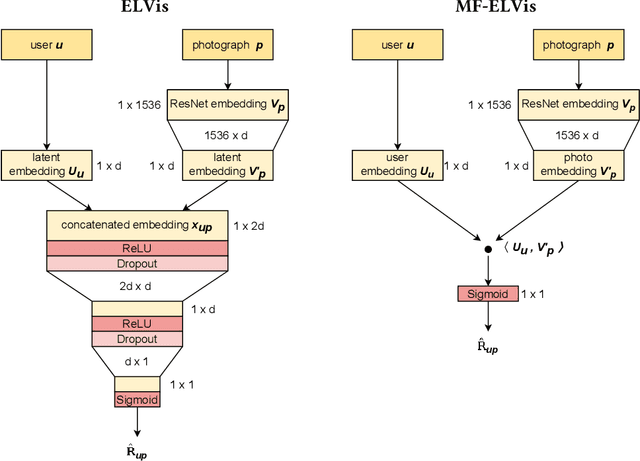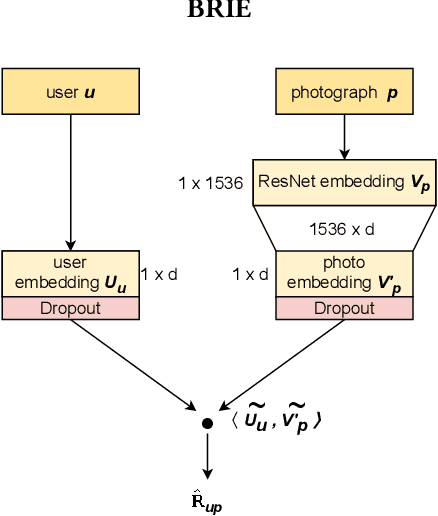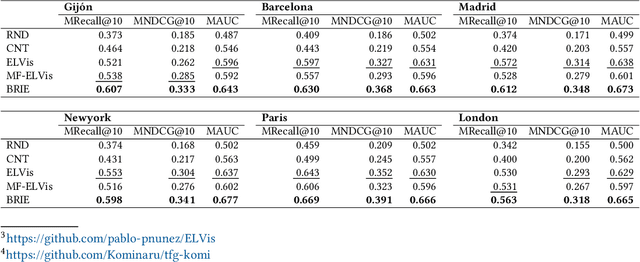Jorge Paz-Ruza
Positive-Unlabelled Learning for Improving Image-based Recommender System Explainability
Jul 09, 2024Abstract:Among the existing approaches for visual-based Recommender System (RS) explainability, utilizing user-uploaded item images as efficient, trustable explanations is a promising option. However, current models following this paradigm assume that, for any user, all images uploaded by other users can be considered negative training examples (i.e. bad explanatory images), an inadvertedly naive labelling assumption that contradicts the rationale of the approach. This work proposes a new explainer training pipeline by leveraging Positive-Unlabelled (PU) Learning techniques to train image-based explainer with refined subsets of reliable negative examples for each user selected through a novel user-personalized, two-step, similarity-based PU Learning algorithm. Computational experiments show this PU-based approach outperforms the state-of-the-art non-PU method in six popular real-world datasets, proving that an improvement of visual-based RS explainability can be achieved by maximizing training data quality rather than increasing model complexity.
Positive-Unlabelled Learning for Identifying New Candidate Dietary Restriction-related Genes among Ageing-related Genes
Jun 14, 2024Abstract:Dietary Restriction (DR) is one of the most popular anti-ageing interventions, prompting exhaustive research into genes associated with its mechanisms. Recently, Machine Learning (ML) has been explored to identify potential DR-related genes among ageing-related genes, aiming to minimize costly wet lab experiments needed to expand our knowledge on DR. However, to train a model from positive (DR-related) and negative (non-DR-related) examples, existing ML methods naively label genes without known DR relation as negative examples, assuming that lack of DR-related annotation for a gene represents evidence of absence of DR-relatedness, rather than absence of evidence; this hinders the reliability of the negative examples (non-DR-related genes) and the method's ability to identify novel DR-related genes. This work introduces a novel gene prioritization method based on the two-step Positive-Unlabelled (PU) Learning paradigm: using a similarity-based, KNN-inspired approach, our method first selects reliable negative examples among the genes without known DR associations. Then, these reliable negatives and all known positives are used to train a classifier that effectively differentiates DR-related and non-DR-related genes, which is finally employed to generate a more reliable ranking of promising genes for novel DR-relatedness. Our method significantly outperforms the existing state-of-the-art non-PU approach for DR-relatedness prediction in three relevant performance metrics. In addition, curation of existing literature finds support for the top-ranked candidate DR-related genes identified by our model.
Beyond RMSE and MAE: Introducing EAUC to unmask hidden bias and unfairness in dyadic regression models
Jan 19, 2024Abstract:Dyadic regression models, which predict real-valued outcomes for pairs of entities, are fundamental in many domains (e.g. predicting the rating of a user to a product in Recommender Systems) and promising and under exploration in many others (e.g. approximating the adequate dosage of a drug for a patient in personalized pharmacology). In this work, we demonstrate that non-uniformity in the observed value distributions of individual entities leads to severely biased predictions in state-of-the-art models, skewing predictions towards the average of observed past values for the entity and providing worse-than-random predictive power in eccentric yet equally important cases. We show that the usage of global error metrics like Root Mean Squared Error (RMSE) and Mean Absolute Error (MAE) is insufficient to capture this phenomenon, which we name eccentricity bias, and we introduce Eccentricity-Area Under the Curve (EAUC) as a new complementary metric that can quantify it in all studied models and datasets. We also prove the adequateness of EAUC by using naive de-biasing corrections to demonstrate that a lower model bias correlates with a lower EAUC and vice-versa. This work contributes a bias-aware evaluation of dyadic regression models to avoid potential unfairness and risks in critical real-world applications of such systems.
Sustainable Transparency in Recommender Systems: Bayesian Ranking of Images for Explainability
Jul 27, 2023



Abstract:Recommender Systems have become crucial in the modern world, commonly guiding users towards relevant content or products, and having a large influence over the decisions of users and citizens. However, ensuring transparency and user trust in these systems remains a challenge; personalized explanations have emerged as a solution, offering justifications for recommendations. Among the existing approaches for generating personalized explanations, using visual content created by the users is one particularly promising option, showing a potential to maximize transparency and user trust. Existing models for explaining recommendations in this context face limitations: sustainability has been a critical concern, as they often require substantial computational resources, leading to significant carbon emissions comparable to the Recommender Systems where they would be integrated. Moreover, most models employ surrogate learning goals that do not align with the objective of ranking the most effective personalized explanations for a given recommendation, leading to a suboptimal learning process and larger model sizes. To address these limitations, we present BRIE, a novel model designed to tackle the existing challenges by adopting a more adequate learning goal based on Bayesian Pairwise Ranking, enabling it to achieve consistently superior performance than state-of-the-art models in six real-world datasets, while exhibiting remarkable efficiency, emitting up to 75% less CO${_2}$ during training and inference with a model up to 64 times smaller than previous approaches.
 Add to Chrome
Add to Chrome Add to Firefox
Add to Firefox Add to Edge
Add to Edge